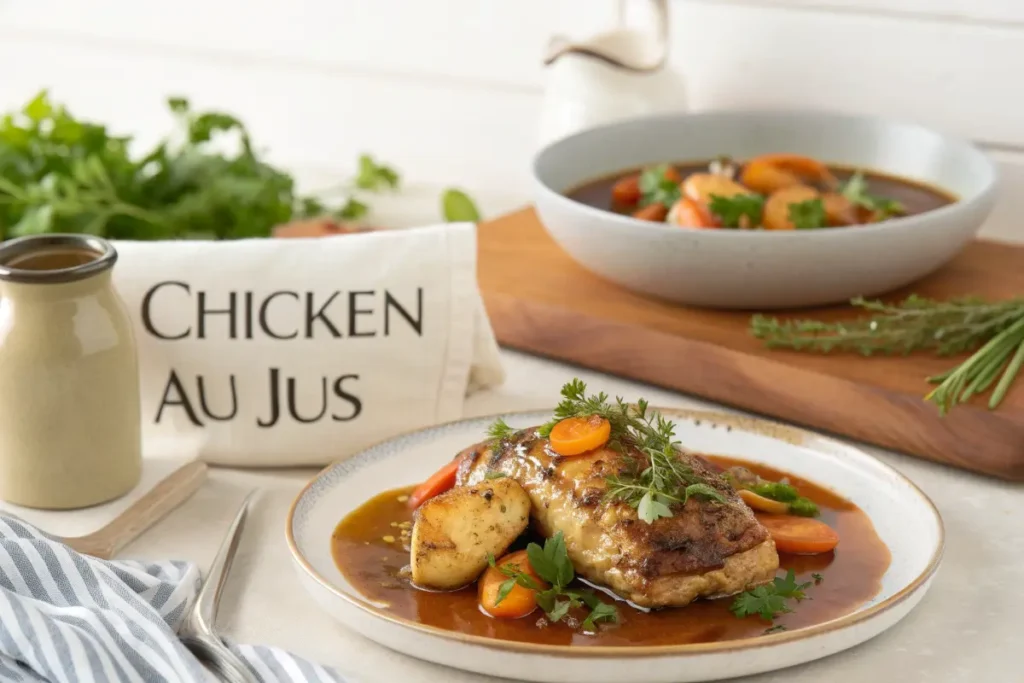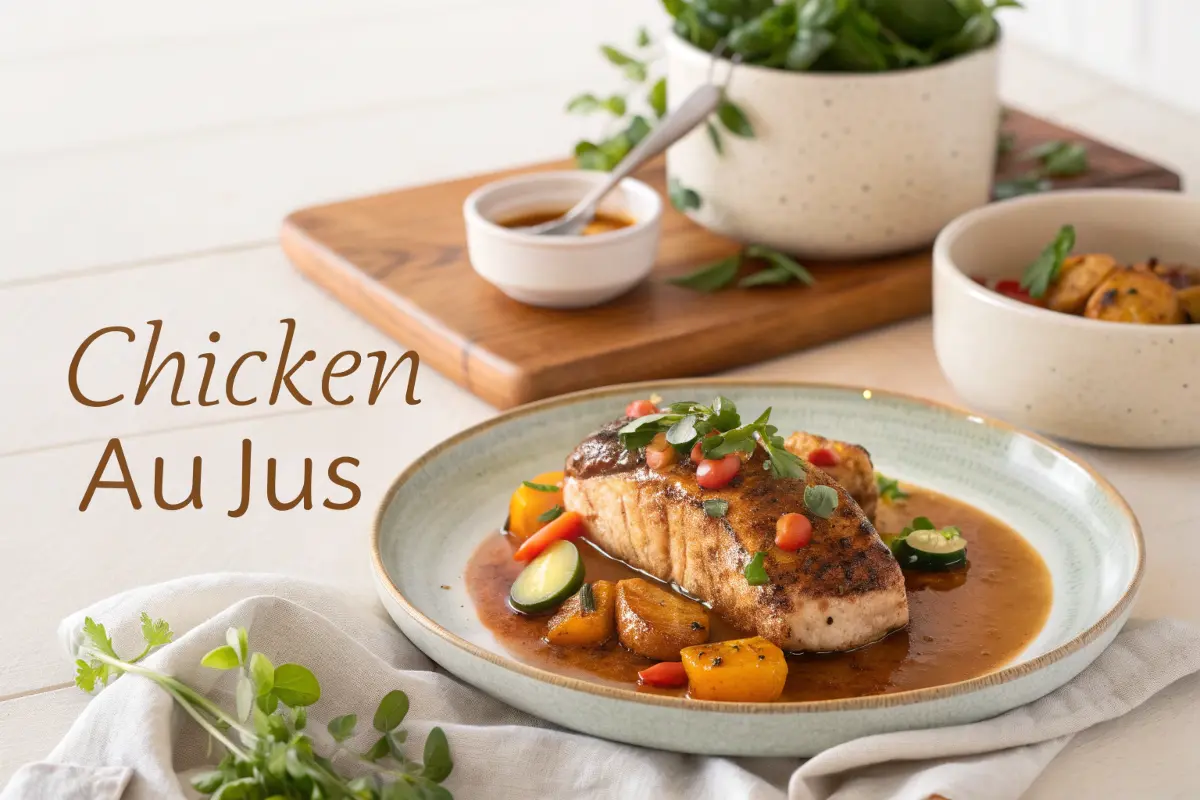What is Chicken au Jus?
Chicken au jus, a French-inspired culinary classic, is a dish that features tender, flavorful chicken served with a light yet rich sauce made from its own pan drippings. The term “au jus” translates to “with juice” in French, signifying the natural, savory juices derived during cooking.
This technique involves deglazing the pan with a liquid like wine, broth, or water, and then reducing it to create a concentrated, flavorful sauce. Chicken au jus is not heavy like gravy; instead, it’s light, aromatic, and designed to enhance the natural flavors of the chicken.
Often served alongside roasted vegetables, mashed potatoes, or crusty bread, chicken au jus combines simplicity with elegance. It’s a dish that celebrates both culinary technique and the beauty of wholesome, high-quality ingredients.
Definition and Origin
Chicken au jus is a culinary term referring to chicken served with its natural juices. The phrase “au jus” comes from French, meaning “with juice,” emphasizing the importance of using flavorful liquid from the chicken’s drippings. Unlike traditional gravies, au jus is thinner and has a lighter texture, which enhances the natural flavors of the meat rather than overpowering them.
Historically, the concept of serving meat with juices originates from French cuisine, which prioritizes preserving the authenticity of ingredients. Au jus became popular during the 17th century when chefs focused on creating sauces and reductions that complemented rather than masked the primary dish. This technique eventually spread across Europe and the Americas, influencing modern culinary practices.
Historical Background
French aristocracy heavily influenced the use of au jus. In elite households, chefs created elaborate meals where each element had to shine, leading to the development of techniques like deglazing pans for drippings. Over time, this practice became synonymous with sophistication and high-quality dining.
In the United States, the dish gained popularity through the introduction of French Dip sandwiches in the early 1900s. While au jus traditionally accompanied roast beef, its use with chicken evolved as chefs sought to replicate the richness and depth of beef-based jus for poultry. Today, it is a staple in fine dining and home cooking, revered for its simplicity and versatility.
Culinary Uses
Chicken au jus has earned its place as a versatile component of many dishes. It serves multiple purposes, from enhancing flavor to providing a touch of elegance:
- Flavor Enhancer: The rich, savory juices elevate the taste of the chicken by infusing it with aromatic herbs and spices.
- Moisture Retention: Drizzling au jus over chicken keeps the meat tender and juicy, particularly for cuts prone to dryness, like chicken breast.
- Base for Sauces: Au jus acts as an excellent base for creating more complex sauces by adding wine, cream, or stock.
It pairs exceptionally well with side dishes like roasted vegetables, mashed potatoes, or crusty bread. The lightness of au jus complements rich sides, creating a balanced meal that satisfies without feeling heavy.

Popularity in Different Cuisines
While its origins are French, chicken au jus has found a home in many global cuisines:
- French Cuisine: It remains a cornerstone, particularly in traditional roasted chicken recipes like poulet rôti au jus. French chefs emphasize simplicity, allowing the natural flavors to take center stage.
- American Cuisine: In the U.S., au jus gained fame through diner-style meals and comfort food classics. Today, it’s a popular accompaniment for roasted or grilled chicken served in both casual and fine-dining settings.
- Asian Adaptations: Asian cuisines, especially Japanese and Chinese, have incorporated au jus techniques by using soy sauce, mirin, or ginger in the juices, offering a fusion of flavors.
- Mediterranean Variants: Mediterranean chefs often enhance their au jus with garlic, olive oil, and rosemary, aligning with their flavor profiles.
Cultural Significance
Chicken au jus has grown from a niche technique to a widely respected culinary practice, celebrated for its ability to elevate even the simplest meals. Its adaptability across cultures and cuisines demonstrates its universal appeal.
Variations of Chicken au Jus Recipes
Regional Adaptations
Chicken au jus, while rooted in French cuisine, has evolved significantly across regions. Each adaptation reflects local ingredients and cooking traditions:
- French Style: True to its origins, the French version focuses on simplicity. Using just chicken drippings, white wine, and a hint of thyme, this version emphasizes elegance and natural flavors.
- American Twist: In the U.S., au jus is often thickened slightly for a heartier texture. Ingredients like Worcestershire sauce or a splash of cream give it a comforting touch.
- Mediterranean Influence: Mediterranean variations incorporate olive oil, lemon juice, rosemary, and garlic. These additions infuse the au jus with bright, herbaceous notes that pair beautifully with grilled chicken.
- Asian Fusion: Asian adaptations use soy sauce, ginger, and sesame oil in place of traditional wine and herbs. These flavors create a rich, umami-packed jus that complements dishes like teriyaki chicken.
- Latin American Flair: Incorporating spices like cumin, chili powder, and lime juice, this version of chicken au jus is bold and vibrant, making it ideal for taco fillings or rice bowls.
Low-Sodium and Healthy Versions
For those mindful of their sodium intake or seeking a lighter option, there are creative ways to enjoy chicken au jus without compromising flavor:
- Herb-Infused Broths: Replace high-sodium chicken stock with homemade, unsalted broth infused with fresh herbs like parsley, thyme, and bay leaves.
- Vegetable-Based Alternatives: Use pureed vegetables like carrots or celery to thicken and flavor the jus naturally.
- Low-Sodium Seasonings: Opt for low-sodium soy sauce or seasoning blends that rely on spices instead of salt.
- Healthy Fats: Substitute butter with heart-healthy olive oil to reduce saturated fat content.
Pairing Options
Pairing the right sides and flavors with chicken au jus can elevate the entire meal:
- Traditional Pairings:
- Mashed potatoes or roasted sweet potatoes soak up the savory juices beautifully.
- Lightly steamed vegetables like green beans or asparagus provide a refreshing balance.
- Modern Twists:
- Serve over quinoa or farro for a nutrient-packed base.
- Pair with a fresh arugula salad dressed with lemon vinaigrette for a tangy contrast.
- Bread Lovers:
- Crusty sourdough or French baguette is perfect for sopping up every last drop of the flavorful jus.
Creative Twists to Traditional Recipes
For adventurous cooks, here are some innovative ways to transform classic chicken au jus into something extraordinary:
- Spiced Citrus Jus: Add orange or lemon zest, cinnamon, and star anise to the jus for a warm, fragrant twist.
- Vegetarian Adaptation: Create an “au jus” using roasted mushrooms and vegetable drippings for a plant-based option.
- Creamy Variation: Swirl in a dollop of crème fraîche or heavy cream for a velvety finish that pairs well with roasted chicken.
- Sweet & Savory Blend: Incorporate a touch of honey or maple syrup for a hint of sweetness that balances the savory notes.

Global Fusion Recipes
- Indian-Inspired Jus: Infuse the sauce with turmeric, cumin, and coriander for a spice-forward take.
- Korean Barbecue Twist: Mix in gochujang (Korean chili paste) and sesame oil for a smoky, spicy jus.
- Italian Take: Add sun-dried tomatoes, basil, and Parmesan for a distinctly Italian flair.
Chicken au jus is a canvas for culinary creativity. By experimenting with regional flavors, healthy swaps, and innovative pairings, this classic dish can be reimagined to suit any palate.
Common Mistakes to Avoid
Overcooking the Sauce
One of the biggest pitfalls in making chicken au jus is overcooking the sauce. Prolonged cooking can cause the jus to become too thick or overly concentrated, ruining the balance of flavors.
- Tip: Once the sauce reaches the desired consistency, remove it from the heat. A perfect jus should remain light and slightly runny, enhancing the dish rather than overpowering it.
- Solution: If the sauce reduces too much, add a small amount of chicken broth or water to restore its texture.
Using the Wrong Ingredients
The key to an authentic and flavorful chicken au jus lies in choosing the right ingredients. Using artificial or low-quality substitutes can compromise its taste:
- Examples of Mistakes:
- Using overly salty pre-packaged broths can result in an excessively salty jus.
- Cheap wine or skipping wine altogether can make the sauce less complex.
- Tips for Success:
- Opt for fresh herbs over dried when possible, as they offer a more vibrant flavor.
- Use homemade or low-sodium chicken stock for better control over seasoning.
Ignoring the Pan Drippings
Pan drippings are the heart and soul of chicken au jus. Skipping this crucial element strips the sauce of its rich, savory depth:
- Common Error: Discarding the browned bits (fond) left at the bottom of the pan after cooking chicken. These bits are packed with flavor.
- Correct Approach:
- Deglaze the pan with wine, broth, or water to release the flavorful bits.
- Use a wooden spoon to scrape the pan and incorporate the fond into your jus.
Skipping the Reduction Step
Reduction is essential for intensifying the flavors in chicken au jus. Skipping this step results in a watery, underwhelming sauce.
- Why It’s Important:
- Reduction concentrates the flavors, giving the sauce a rich and robust profile.
- How to Avoid This Mistake:
- Allow the liquid to simmer gently until it reaches the desired thickness.
- Monitor the process carefully to avoid over-reducing, which can make the sauce too salty.
Other Common Mistakes to Watch For
- Adding Ingredients Too Quickly:
- Introduce liquids gradually to ensure proper blending and consistency.
- Neglecting to Taste as You Cook:
- Frequent tasting allows you to adjust seasoning and prevent mishaps.
Nutritional Benefits of Chicken au Jus
Calories and Macros
Chicken au jus is a flavorful yet relatively light addition to your meal. Its nutritional profile depends largely on the ingredients used:
- Average Nutritional Breakdown (per serving):
- Calories: 50-100 (depending on butter and wine usage).
- Protein: Minimal, as the jus primarily enhances the chicken.
- Fat: 2-5g, mainly from pan drippings or added butter.
- Carbs: Typically under 5g, unless thickened with flour or starch.
Vitamins and Minerals
Chicken au jus provides trace amounts of essential nutrients, particularly when made with wholesome ingredients:
- Key Nutrients:
- Iron: Found in pan drippings, supporting healthy blood function.
- Potassium: From natural broth, aids in muscle and nerve health.
- Vitamin B6: Contributes to metabolism and energy production.
Adding herbs like thyme or rosemary can also provide antioxidants, which combat inflammation.
How to Make It Healthier
There are numerous ways to make chicken au jus more nutritious while maintaining its signature flavor:
- Swap Ingredients:
- Use olive oil instead of butter to reduce saturated fat.
- Opt for unsalted or homemade chicken broth to control sodium.
- Add Vegetables:
- Incorporate finely chopped onions, garlic, or celery into the jus for added fiber and nutrients.
- Lighten the Sauce:
- Avoid cream or heavy thickeners to keep the sauce light.

Suitable Diets and Audiences
Chicken au jus can fit into a variety of dietary preferences and lifestyles, making it versatile for many audiences:
- Low-Calorie Diets:
- The sauce adds flavor without significantly increasing calorie counts.
- Low-Sodium Diets:
- Using homemade broth ensures better control over sodium levels.
- Paleo and Keto Diets:
- This dish aligns with paleo and keto guidelines when thickened naturally or left light.
- Family-Friendly:
- Its mild yet rich flavor appeals to both children and adults.
Benefits of Including Chicken au Jus in Your Meals
- Flavor Enhancement:
- The jus enhances plain chicken, encouraging healthier eating habits without resorting to heavy sauces.
- Hydration:
- Its light, broth-based nature contributes to hydration compared to dry meals.
- Customizable:
- Easily tailored to meet individual health goals or taste preferences.
By avoiding common pitfalls and focusing on its nutritional benefits, chicken au jus becomes a dish that’s as satisfying as it is healthy.
History of the Term “Au Jus”
Origins of the Phrase
The term au jus finds its roots in French culinary tradition, where it translates to “with juice.” This technique dates back centuries, emerging as a hallmark of French cuisine. It refers to serving meat with its natural juices, lightly seasoned and cooked to perfection.
- Cultural Significance:
- French cooking emphasizes minimalism, letting natural flavors shine. Au jus embodies this philosophy.
- Historically, it was a way to maximize the use of meat, creating a flavorful accompaniment with minimal waste.
Etymology and Cultural Context
- Etymology:
- The word jus comes from Latin “jus,” meaning broth or juice, eventually evolving into the French term.
- Cultural Context:
- In medieval France, roasting meats and collecting the drippings was a common practice. These drippings were seasoned and poured back over the meat to enhance its flavor.
- Modern Usage:
- Today, au jus is a globally recognized term synonymous with sophistication in dining.
Influence on Global Cuisines
While au jus originated in France, its technique has influenced cuisines worldwide:
- American Cuisine:
- Popular in dishes like French dip sandwiches, where the jus serves as a dipping sauce.
- Asian Interpretations:
- Soy-based reductions in Chinese cuisine mirror the essence of au jus.
- Italian Variations:
- Italians use similar methods in dishes like arrosto with pan juices.
Historical Recipes
Early recipes for au jus were straightforward, focusing on natural meat drippings.
- Traditional Preparation:
- Meat was roasted on spits, and the drippings were collected in pans.
- Herbs like thyme, bay leaves, and parsley were often added for aroma.
- Evolution Over Time:
- Modern recipes incorporate stock or wine to intensify flavors, reflecting contemporary tastes.
Comparing Chicken au Jus with Other Sauces
Difference Between Au Jus and Gravy
Though au jus and gravy share similarities, they differ in texture, preparation, and purpose.
- Au Jus:
- Thin and light, meant to enhance the natural flavor of meat.
- Made primarily from pan drippings, sometimes with a splash of stock or wine.
- Gravy:
- Thicker, achieved by adding flour or cornstarch as a thickener.
- Often more seasoned, serving as a standalone side.
Unique Aspects of Au Jus
What sets au jus apart from other sauces is its simplicity and focus on natural flavors.
- Minimal Ingredients:
- Typically uses only pan drippings, broth, wine, and light seasoning.
- Versatility:
- Complements not just chicken but also beef, pork, and lamb dishes.
- Nutritional Benefits:
- Lower in calories compared to heavy, cream-based sauces.
Sauces That Complement Chicken
Besides au jus, several sauces pair wonderfully with chicken, each offering a unique flavor profile:
- Mushroom Sauce:
- Creamy and earthy, great for comfort dishes.
- Lemon Butter Sauce:
- A zesty option that balances rich chicken flavors.
- Barbecue Sauce:
- Smoky and sweet, perfect for grilled or roasted chicken.
Popular Culinary Debates
The simplicity of au jus often sparks debates in the culinary world:
- To Thicken or Not?
- Purists argue against thickening, insisting on preserving its light consistency. Others favor slight thickening for a modern touch.
- Stock vs. Wine Base:
- Some chefs prefer the complexity of wine, while others opt for the neutrality of chicken stock.
FAQs
- What is the meaning of chicken au jus?
Chicken au jus means chicken served with its natural juices, enhanced by pan drippings and light seasoning. - How to thicken a chicken jus?
Thicken chicken jus by adding a cornstarch or flour slurry, whisking until the desired consistency is achieved. - What’s the difference between au jus and gravy?
Au jus is lighter, made from natural juices, while gravy is thicker, often using flour or roux as a base. - What is jus rôti?
Jus rôti refers to a roasted meat’s natural juices, typically served as a light and flavorful sauce.
Conclusion:
Chicken au jus isn’t just a recipe—it’s a celebration of culinary finesse and flavor. Rooted in tradition yet versatile enough to adapt to modern tastes, this dish perfectly balances simplicity and sophistication. Whether you’re preparing it for a quiet dinner at home or an elaborate feast, chicken au jus delivers a rich and satisfying experience that can elevate any occasion.
If you’re a fan of exploring various chicken dishes, you might also enjoy trying this Marry Me Chicken Pasta Recipe or indulging in the flavors of Houston Hot Chicken for something bolder.
By mastering the essential techniques, from deglazing the pan to achieving the perfect reduction, you can turn simple ingredients into a masterpiece. For lighter pairings, consider Healthy Cottage Cheese Recipes as sides to balance the richness of your chicken au jus.
So why not give chicken au jus a try? With its timeless appeal and endless possibilities, this dish is sure to become a favorite in your culinary repertoire. Bring your own twist to the table, and let the art of chicken au jus shine in every bite. Looking for inspiration? Don’t miss our guide to Quick Dinner Ideas for Two to pair with this delightful recipe.

